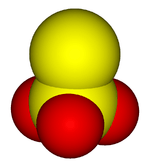Thiosulfate


Thiosulfate (S
2O2−
3) (IUPAC-recommended spelling; sometimes thiosulphate in British English) is an oxyanion of sulfur.
The prefix thio- indicates that the thiosulfate ion is a sulfate ion with one oxygen replaced by sulfur. Thiosulfate has a tetrahedral molecular shape with C3v symmetry. Thiosulfate occurs naturally and is produced by certain biochemical processes. It rapidly dechlorinates water and is notable for its use to halt bleaching in the paper-making industry. Thiosulfate is also useful in smelting silver ore, in producing leather goods, and to set dyes in textiles.
Sodium thiosulfate, commonly called hypo (from "hyposulfite"), was widely used in photography to fix black and white negatives and prints after the developing stage; modern 'rapid' fixers use ammonium thiosulfate as a fixing salt because it acts three to four times faster.[1] Some bacteria can metabolise thiosulfates.[2]
Formation
Thiosulfate is produced by the reaction of sulfite ion with elemental sulfur, and by incomplete oxidation of sulfides (pyrite oxidation), sodium thiosulfate can be formed by disproportionation of Sulfur dissolving in sodium hydroxide (similar to phosphorus).
Reactions
Thiosulfates are stable only in neutral or alkaline solutions, but not in acidic solutions, due to decomposition to sulfite and sulfur, the sulfite being dehydrated to sulfur dioxide:
- S
2O2−
3 (aq) + 2 H+ (aq) → SO2 (g) + S (s) + H2O (l)
This reaction may be used to generate an aqueous suspension of sulfur and demonstrate the Rayleigh scattering of light in physics. If white light is shone from below, blue light is seen from sideways and orange from above, due to the same mechanisms that color the sky at mid-day and dusk..
Thiosulfates react with halogens differently, which can be attributed to the decrease of oxidizing power down the halogen group:
- 2 S
2O2−
3 (aq) + I2 (aq) → S
4O2−
6 (aq) + 2 I− (aq)
- S
2O2−
3 (aq) + 4 Br2 (aq) + 5 H2O(l) → 2 SO2−
4 (aq) + 8 Br− (aq) + 10 H+ (aq)
- S
2O2−
3 (aq) + 4 Cl2 (aq) + 5 H2O (l) → 2 SO2−
4 (aq) + 8 Cl− (aq) + 10 H+ (aq)
In acidic conditions, thiosulfate causes rapid corrosion of metals; steel and stainless steel are particularly sensitive to pitting corrosion induced by thiosulfate. Addition of molybdenum to stainless steel is needed to improve its resistance to pitting (AISI 316L hMo). In alkaline aqueous conditions and medium temperature (60 °C), carbon steel and stainless steel (AISI 304L, 316L) are not attacked, even at high concentration of base (30%w KOH), thiosulfate (10%w) and in presence of fluoride ion (5%w KF).
The natural occurrence of the thiosulfate group is practically restricted to a very rare mineral sidpietersite, Pb4(S2O3)O2(OH)2,[3] as the presence of this anion in the mineral bazhenovite was recently disputed.[4]
Thiosulfate extensively forms complexes with transition metals hence a common use is dissolving silver halides in film photography developing.[5] Thiosulfate is also used to extract or leach gold (sodium thiosulfate) and silver from their ores as a less toxic alternative to cyanide.[6]
Nomenclature
The systematic additive IUPAC name is trioxido-1κ3O-disulfate(S—S)(2−), the name of its corresponding acid is dihydroxido-1κ2O-oxido-1κ1O-disulfur(S—S). The external sulfur has an oxidation state of (−II) while the central sulfur atom has oxidation number as (+VI).
Biochemistry
The enzyme rhodanase catalyzes the detoxification of cyanide by thiosulfate:
CN− + S
2O2−
3 → SCN− + SO2−
3.
Sodium thiosulfate has been considered as an empirical treatment for cyanide poisoning, along with hydroxocobalamin. It is most effective in a pre-hospital setting, since immediate administration by emergency personnel is necessary to reverse rapid intracellular hypoxia caused by the inhibition of cellular respiration, at complex IV.[7][8][9][10]
It activates TST (thiosulfate sulfur transferase) in mitochondria. TST is associated with protection against obesity and type II (insulin resistant) diabetes.[11][12]
See also
References
- ↑ Sowerby, A. L. M., ed. (1961). Dictionary of Photography: A Reference Book for Amateur and Professional Photographers (19th ed.). London: Illife Books Ltd.
- ↑ C.Michael Hogan. 2011. Sulfur. Encyclopedia of Earth, eds. A.Jorgensen and C.J.Cleveland, National Council for Science and the environment, Washington DC
- ↑ handbookofmineralogy.org, Mineral Handbook
- ↑ minsocam.org
- ↑ antoine.frostburg.edu
- ↑ antoine.frostburg.edu
- ↑ Hall, Alan H.; Dart, Richard; Bogdan, Gregory (2007). "Sodium Thiosulfate or Hydroxocobalamin for the Empiric Treatment of Cyanide Poisoning?". Annals of Emergency Medicine. 49 (6): 806. PMID 17098327. doi:10.1016/j.annemergmed.2006.09.021.
- ↑ Hamel, J. (2011). "A Review of Acute Cyanide Poisoning with a Treatment Update" (PDF). Critical Care Nurse. 31 (1): 72–81; quiz 82. PMID 21285466. doi:10.4037/ccn2011799.
- ↑ Shepherd, G.; Velez, L. I (2008). "Role of Hydroxocobalamin in Acute Cyanide Poisoning". Annals of Pharmacotherapy. 42 (5): 661. PMID 18397973. doi:10.1345/aph.1K559.
- ↑ Miles, Bryant (February 24, 2003). "Inhibitors & Uncouplers" (PDF). Texas A&M University. Retrieved 25 November 2015.
- ↑ Stylianou, I. M.; et al. (2005). Physiol. Genomics. 20 (3): 224–232 http://physiolgenomics.physiology.org/content/20/3/224. Missing or empty
|title=(help) - ↑ Morton, N. M.; Beltram, J.; Carter, R. N.; et al. (2016). "Genetic identification of thiosulfate sulfurtransferase as an adipocyte-expressed antidiabetic target in mice selected for leanness". Nature Medicine.